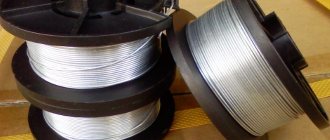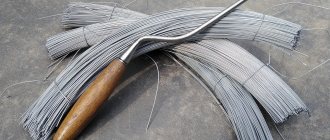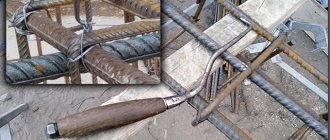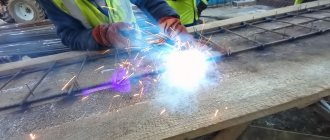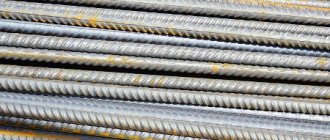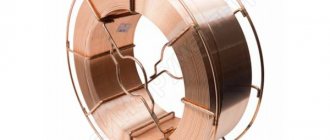The reinforcement frame is an essential element of a concrete foundation constructed using monolithic technology. For its manufacture, steel or polymer composite reinforcing bars are used. The most popular option for connecting steel reinforcement into a single structure is welding. However, when building on heaving soils, it is not recommended to create a reinforcing frame using a welding machine. During seasonal soil movements, a foundation with rigidly connected reinforcement is subject to deformations that reduce performance characteristics. A more reliable option in such cases is to tie the reinforcement using tying wire.
Application and production technology
Wire for tying reinforcement is most popular in monolithic construction. With the help of concrete and reinforcement, buildings of the most unusual shapes are created, thanks to its technology and the integrity of the structure from the foundation to the roof. It is in this area that more than one object can do without the use of wire.
The wire is used for reinforcement of such reinforced concrete structures as:
- Foundations (strip, slab, pile).
- Walls, columns, beams and lintels.
- Stairs.
- Monolithic floors.
- Floor screeds.
The most important parameters of wire for tying reinforcement are flexibility and strength. It must provide a reliable connection of intersecting reinforcement elements, and at the same time be soft and pliable for quick work.
These characteristics are ensured by the properties of the material, production technology and subsequent heat treatment.
The material for production is low-carbon steel. Wire is a product of the process of drawing a workpiece through dies with a given diameter. Under the influence of pressure and in the process of plastic deformation of the workpiece, the steel structure is refined and improved, and a hardened hardened layer is formed on the surface.
However, after such a procedure, significant internal stresses remain in the metal, which do not allow the resulting product to bend; it will be rigid and brittle. Therefore, in order to be able to use the wire for knitting, it is subjected to heat treatment - annealing. During the annealing process, relaxation and stress relief occur. Thus, the result is a durable, easy-to-use product.
This is interesting: Knitting fiberglass reinforcement for the foundation: we reinforce it correctly
What should you know about the products of metal deoxidation and oxidation?
Increasing the level of oxide non-metallic inclusions in the weld composition, in most cases, reduces its quality. Previously, it was believed that when welding in an environment of oxidizing protective gases and using bare wire, it was impossible to ensure good properties of the weld due to contamination of the alloy with non-metallic compounds.
However, it later turned out that when welding is carried out in an environment of carbon dioxide (as well as other oxidizing gases), only about one percent of the oxide that occurs in the welding zone is retained in the metal weld as non-metallic inclusions. But we must remember that even such a small number of additional inclusions can negatively affect the characteristics of the weld.
An important condition for cleaning the weld metal from non-metallic oxides is the choice of the ratio of manganese and silicon in the metal. The more manganese relative to silicon, the fewer harmful inclusions.
Classification and varieties
Reinforcement wire is classified into varieties according to the following parameters:
- presence or absence of a protective coating;
- heat treatment;
- strength class.
Depending on the presence of a protective coating, the material is divided into two types: made of ordinary low-carbon steel and galvanized. The coating is applied by hot-dip galvanizing, which involves soaking coils of wire in baths of molten zinc.
data-ad-client=»ca-pub-8514915293567855″ data-ad-slot=»1955705077″>
Material with a protective coating is divided into two classes - 1C and 2C. The differences between them lie in the thickness of the galvanizing layer; in class 2C material, the protective layer is much thicker: for comparison - 155 versus 85 g/m
2
in wire with a diameter of 6 mm. An alternative to galvanized materials is MNZHKT wire made of a copper-nickel alloy, however, its use in construction is unjustified due to its high cost.
Galvanized wire VR-1
According to the type of hardening, reinforcing wire is classified into untreated and annealed (marked with the letter O). The essence of heat treatment is to heat the material to a given temperature in a blast furnace and then cool it. As a result of annealing, the crystalline structure of the metal changes and the internal stress of the steel is destroyed, which provides increased elasticity and mechanical strength of the wire.
Depending on the strength class, products are classified into two groups B-1 (regular) and B-2 (high-strength). The difference between them lies in the brand of alloys used; low-carbon steel is used for the manufacture of wire V-1, and steel with an increased amount of alloying components is used for wire V-2. Material B-2 is used to connect frames made of prestressed reinforcement, while class B-1 is intended for the installation of non-prestressed structures.
Dimensions and weight
The diameter of the material depends on the presence of a protective coating - galvanized wire is produced in diameters of 0.2-6 mm, without coating - 0.16-10 mm . From the factory, products are supplied in skeins (weight from 15 to 250 kg) or reels (500-1500 kg). The skein should consist of one piece of wire, the coil - no more than 3.
Here is a table of knitting wire weight 1 meter, BP brand, the most popular on the market:
- VR-1 (diameter 1 mm) - weight 0.012 kg;
- VR-2 (diameter 2 mm) - weight 0.025 kg;
- VR-3 (diameter 3 mm) - weight 0.06 kg;
- VR-4 (diameter 4 mm) - weight 0.1 kg;
- VR-6 (diameter 6 mm) - weight 0.23 kg.
A characteristic feature of the VR brand is the presence of corrugated walls, due to which the adhesion (adhesion) of the material to the reinforcement bars increases, which has a positive effect on the overall strength of reinforced concrete structures.
Wire "Cossack"
«
Recently, wire for tying reinforcement with rings, also called “Kazachka”, has become widespread on the market. It is produced in the form of lengths of 8, 10, 12 and 14 cm, at the ends of which there are rings for a hook for tying. Connecting reinforcement with “Kazachka” is carried out much faster than with a standard analogue, since there is no need to cut and independently form rings. The material is supplied in the form of spools consisting of 1-5 thousand pieces.
Knitting reinforcement with wire (video)
How to knit?
To assemble a frame from 10-14 mm reinforcement bars, you need to use wire with a diameter of 1.2-1.4 mm . If the material has poor elasticity, the coil must be kept in a fire for 20-30 minutes, and then allowed to cool at natural temperature. You can use products with a smaller diameter, but in this case, when making a connection, you will need to bend it twice.
You will need a special tool - a crochet hook, which can be manual or mechanical. You can buy a hand hook for 100-300 rubles, or you can make it from a trowel or paint roller, bending and sharpening their end.
Instructions for crocheting reinforcement
Reinforcing wire is knitted quite simply - a 30 cm long piece is folded in half, at a distance of 1/3 from the loop the wire is bent around the finger and tucked under the overlap of the reinforcement. A hook is inserted into the loop, after which the free end of the material is bent through the reinforcement and inserted into the hook bed.
Then, by rotating the tool, the connection is tightened. The number of turns of the hook is determined by eye so that the connection is strong enough, but does not overtighten.
In the process of manufacturing the frame of reinforced concrete structures, it is necessary to maintain a protective layer of concrete 3-5 cm thick. Here, instead of special stands, you can use cut rings of plastic plumbing pipes with a diameter of 4-5 cm.
Related articles:
Portal about fittings » Mesh » Wire » Nuances of using tying wire
What is tying wire?
We are talking about a product obtained from wire rod - a billet of low-carbon steel. Knitting wire is a reliable and elastic fastening element that bends easily and locks into the desired position. Supplied in large coils and used in the assembly of foundation frames, floors, and floor screeds. Unlike welding, which degrades the quality of the metal in the heating zone, connecting reinforcement with wire does not have this disadvantage. It is resistant to deformation and bending loads, does not corrode, which has a positive effect on strength.
Where is tying wire used?
The main area of application is construction, which involves connecting metal products into a durable and wear-resistant frame, but wire for tying reinforcement is also used in other areas:
- Production of steel ropes.
- Production of masonry nets, barbed wire, chain-link.
- Installation and packaging of goods.
- Securing cargo during transportation.
Work technology
Knitting of reinforcement for a strip foundation is carried out using the following technology:
- Formwork made of wood or other materials is installed, and a fishing line is stretched inside it to indicate the upper plane of the foundation.
- At the bottom, 5 cm in height is marked, from this level the layout of longitudinal rods and ligation of joints begins. Bricks are placed at the bottom to ensure that this condition is met, and vertical reinforcing elements are stuck into the ground. The steel rods are also spaced 5 cm from the formwork walls.
- Longitudinal elements are made solid for a length of 6 m. A bunch of rods are allowed to overlap 25 - 35 cm if the foundation is strip. The slab is long. Metal rods are placed around the perimeter, and the upper and lower reinforced belts are tied onto them.
- Concrete is poured in layers after the knitting is completed, and vibration is used to expel air bubbles.
The reinforcement cage can be knitted in sections outside the formwork and sequentially installed inside the trench, but installation in this way requires more workers. Debris and foreign objects are not allowed in the nodes; there should be no protruding loops or uneven tightening with free ends of the wire in the connection.
How to calculate the amount of tying wire per ton of reinforcement
Calculation of tying wire for reinforcement is based on the following data:
- Construction type . For a heavy structure, the number of strapping elements will be greater than for light structures.
- Type of reinforcing bar . As the diameter of the main rod increases, the amount of binding wire decreases, and as it decreases, it increases.
According to SNiP data, the consumption rate of tying wire when assembling a reinforcing frame is 30 cm per connection unit or 4 kg per ton of reinforcement. To more accurately calculate the amount of material, it is necessary to calculate the number of joining points of embedded products. Based on practical experience, steel bars weighing 100 kg will require from 0.9 to 1.3 kg. The consumption of tying wire per 1 ton of reinforcement should be from 9 to 13 kg. To tie 1 ton of steel bars with a diameter of 28 or 32 mm, you will need about 7 kg of wire, 8 mm - 12 kg.
The most accurate data can be obtained by creating a trial harness. Or use the formula for calculating the length of one turn:
2 x 3.14 (Pi) x cross-sectional radius of reinforcement x 1.03
Count the number of strapping knots and multiply by the length of one turn with a margin. Please note that when transferring the rods you need to make a double connection. Then convert the resulting linear meters into kilograms using the following table:
| Wire diameter, mm | Footage 1 kg, m | Weight 1m, g |
| 0,6 | 450,5 | 2,22 |
| 0,8 | 253,2 | 3,95 |
| 1,0 | 162,0 | 6,17 |
| 1,2 | 112,3 | 8,88 |
| 1,4 | 82,6 | 12,10 |
| 1,6 | 65,4 | 15,30 |
| 1,8 | 50,0 | 20,00 |
| 2,0 | 40,5 | 14,70 |
IMPORTANT! The table shows the weight of wire without zinc coating
Characteristics of tying wire
This material is manufactured with a cross-sectional diameter from 0.5 to 6 mm. Stainless steel knitting wire can be galvanized. Then its thickness increases to 10 mm. To increase strength and elasticity, the product is subjected to heat treatment. When choosing a material that has not been fired, it is necessary to take into account the tensile strength (N/mm²) and cross-sectional area:
- 10 mm
– 390-690; - 8 mm
– 390-780; - 4.5–5 mm
– 390-830; - 3.2–4.5 mm
– 440-930; - 2.5–3.2 mm
– 540-1080; - 1–2.5 mm
– 590-1270; - less than 1 mm
– 690-1370.
Purpose of hardware
Wire for connecting reinforcement plays a key role in the construction of monolithic concrete structures. The main purpose of this material is to link reinforcing elements into a spatial or flat frame. This type of product is used for the production of:
- chain-link mesh;
- ropes;
- masonry mesh;
- prickly hardware;
- to carry out packaging work.
This is interesting: Technology for installing bored piles with casing: installation features, video
BUY WIRE OK
Widely used OK wire is a rolled metal product manufactured by repeated cold drawing from low-carbon hot wire rod in accordance with GOST 3282-74.
The wire has a general purpose, the abbreviation OK stands for “ordinary quality”. The product is used:
- for further processing for the purpose of producing hardware products (nails, cables, wires, nets, fences, trellises for grapes, design elements, etc.);
- as a binding material (for example, for tying reinforcement, forming coils of rolled metal). Hence the name - knitting wire, the price per kg of which depends on the manufacturer and classification characteristics (see below).
Proper use of the hook
Node formation process:
- A piece of 30 cm wire is folded in half and the intersection point of the reinforcing bars is clasped so that the loop on the bend is opposite the tails.
- The hook is inserted into the loop, catches the tails and rotates to wrap the ends around the loop.
- The resulting knot is tightened with force, without breaking the wire.
- The hook is removed from the loop, the remains are trimmed.
Screw hooks are used, which are classified as semi-automatic devices. The tip rotates progressively in the device. If you pull the hook towards you, the tip turns and the wire is tightened. The worker makes minimal effort, and the time to create a knot is reduced by 3 to 5 seconds.
The wire is also folded in half, the hook is inserted into the loop, the end is wrapped around the loop and the hook is pulled towards itself. Turning the handle ensures tightening.
Labeling and classification
All produced knitting wire is manufactured in accordance with GOST – 3282-74 “Low-carbon steel wire for general purpose”. The document regulates all technical characteristics - type, dimensions, manufacturing accuracy, mechanical properties of the material.
GOST specifies the classification of wire according to the following criteria:
- By type of processing - heat-treated or not.
- Depending on the type of coating - with or without galvanized coating.
- In terms of manufacturing accuracy - with increased or normal accuracy.
- According to temporary tensile strength (only for non-annealed) – groups I and II.
Depending on the conditions under which the heat treatment was carried out, the wire can be light or black. Black is obtained by annealing in air; under the influence of oxygen, oxides and scales are formed on the surface of the metal. The light one undergoes heat treatment in an environment of inert gases, its surface is clean, but in terms of technological parameters it is no different from the black one.
Wire can be produced with a diameter from 0.16 to 10 mm without coating, and 0.2 – 6 mm with coating.
A coil of the most popular galvanized binding wire with a diameter of 1.2 mm, weighing 25 kg.
Wire markings include:
- diameter – indicated in millimeters;
- type of treatment – letter O, in case of heat treatment;
- manufacturing accuracy - letter P with increased accuracy;
- surface type – C (light), B (Black)
- presence of zinc coating - 1C or 2C (the number indicates the class).
All produced wire is wound onto coils or spools, undergoes mandatory control, is marked and confirmed with a quality certificate. The products required for use are selected based on the labeling. Each type of knitting “thread” has its own purpose based on the conditions of its use.
The feasibility of using steel wire for tying reinforcement
Wire of various diameters, which is produced in accordance with the requirements of GOST 3282-74, has a general purpose. The material for its manufacture is low-carbon steel. Depending on the purpose, the wire can be additionally subjected to heat treatment, its surface coated with a protective layer of zinc, and manufactured with normal or increased precision. General purpose wire is used to produce nails and various types of fencing. It is also used for tying.
The name of the binding wire is due to the fact that it is most often used specifically for fixing several elements of various structures using the tying method. For this purpose, this product is most often used in construction - to create reinforcement frames. The wire for tying reinforcement must be soft enough, so it is additionally annealed so that it bends better and breaks less when bent.
Heat treated zinc coated binding wire (O-1C)
Using soft annealed wire it is much easier to make a knot that will reliably fix the reinforcement in any spatial position. It is for reasons of ease of bending that products with a diameter in the range of 1.2–1.6 mm are used for tying reinforcement. Due to its small diameter, such wire is easily knitted, allowing you to make various knots on the reinforcement frame.
The diameter range indicated above is optimal, since thinner wire will often break, and thicker wire is more difficult to work with: it does not make it possible to make a strong knot and, accordingly, ensure high reliability of the strapping. The choice of binding wire with or without zinc coating depends only on how durable the connection of the reinforcement frame elements for a concrete structure should be.
Fastening rods using a rebar tying gun
An alternative to connecting reinforcement elements with binding wire is welding, with which you can install metal parts much faster. Meanwhile, it is possible to obtain high-quality and reliable connections of reinforcing bars only through resistance welding, which requires a special apparatus and the experience of a qualified specialist.
If you use conventional electric arc welding for these purposes, you can overheat the joint, as a result, the reinforcement will become more fragile and may break under the influence of significant loads. Concrete structures, the reinforcement frame of which is connected using electric arc welding, are not highly reliable, since they are not able to withstand long-term and peak loads.
If the conditions for installing the reinforcement frame do not provide for the use of welding, its elements are fixed to each other using binding wire. It is also important that high-quality tying of knots does not require high qualifications, and you can learn how to correctly perform such a procedure very quickly. Quality control of this work is also quite simple; to carry it out, it is enough to check whether all nodes of the reinforcement frame have been strapped.
Help with a screwdriver or pliers
A crochet hook without a handle can be used with a screwdriver. The axis of the hook is clamped in the jaws of the head, the wire is hooked and it is rotated with slow acceleration. To prevent the binding from breaking, you need to adjust the rotation cutoff level that the screwdriver is equipped with.
The method of tying reinforcement using pliers has become widespread in the field of reinforcement builders. Some achieve amazing success, outstripping the pace of work of experienced “hookmen”.
Connecting with pliers claims to be the most economical wire consumption. They usually don’t make preparations here—they don’t waste time on it. The wire is taken directly from a small bay. The technology is similar to the “hook” one: a loop is bent at the end of the wire, placed under the reinforcement joint, both ends are clamped with pliers, rotated 2-3 turns and the wire is bitten off. The pliers are sharpened in such a way that they can both securely hold the wire as it rotates and cut the end upon completion of the operation.
The so-called “super pliers” are also in demand. These are also pliers that have a screw notch on one handle and a clip that moves along it. There is no need to rotate them manually. It is enough to pull the clip towards you so that the superpliers begin to rotate around the handle with the clip, like in an automatic hook. After tightening is completed, the wire is cut as with ordinary pliers.
There are other tools and technologies for tying reinforcement with tying wire. So, on large construction sites they use a knitting gun. It does not require any worker qualifications; when you bring its tip to the joint, the device performs mating in 1-2 seconds. The disadvantages of this device are the high price (approximately 30 thousand rubles) and the compression force of the connected rods, which is not entirely satisfactory to specialists. This reason forces construction organizers to use the device only to ensure the initial stability of the frame, and make subsequent connections using crocheted hooks or pliers.
For small volumes of work, knitting is generally done with improvised tools. At best, they use a sharpened and bent screwdriver, at worst, a homemade hook made from a nail or a welding electrode rod with a chipped coating.
Tying reinforcement using a reversible hook, plastic ties and a screwdriver
Some users of our portal prefer to knit reinforcement using a reversible hook.
This is a device in the form of a long handle with a hook at the end, which must be pulled towards you.
Opinions differ about the effectiveness of such a hook. Some people consider the reversible (semi-automatic) hook to be an effective tool. Some people treat it like an unnecessary toy, preferring to knit the reinforcement with a regular crochet hook.
SheriffFORUMHOUSE user
In my opinion, working with a reversible hook is very simple. He pulled it towards himself and the wire began to twist. Both the child and the woman can cope.
FghFORUMHOUSE user
I knit reinforcement only with a semi-automatic machine. Fast, high quality and convenient. An ordinary hook didn’t interest me.
beutifletFORUMHOUSE user
Here is a photo of the working process of crocheting in this way.
DaxFORUMHOUSE user
And I bought both a regular hook and a reversible one. I tried both, and I didn’t like the semi-automatic at all. I knitted everything as usual.
Opinions were divided. According to alex_k11, if you choose a reversible hook, then buy only the right one - with a two-way groove of the working mechanism. There are cheaper and lower quality semi-automatic hooks with a single-thread screw cut on the market. Such hooks jerk when twisted, and they tear the wire.
For clarity, we attach a photo of the “correct” and “incorrect” reversible hook.
Also, reversible hooks may not survive a large amount of work. When grinding the working part of the screw notch, the hook begins to tug. The result is that the wire breaks.
In addition, users of the portal experimented with using a screwdriver as a device for tying reinforcement.
Opinions about the effectiveness of such a “machine gun” are also divided.
KomissarovaForumHouse participant
I knitted the reinforcement myself using a screwdriver with a hexagon “four” inserted into the chuck. I really liked it. Convenient and high speed.
According to FORUMHOUSE user andre777, “Shurik” is of no use. It is necessary to catch the torque of tightening the rotation. I increased the torque a little and broke the wire. Reduced it - didn’t make it enough. Moreover, adjustments have to be made constantly, because The stiffness of the wire may vary from batch to batch.
Constantly carrying a screwdriver in your hands means you quickly get tired, especially with large volumes and when working in inconvenient places.
andre777FORUMHOUSE user
Nothing better than a simple hook has yet been invented.
Another option that speeds up and simplifies installation is tying the reinforcement with plastic ties.
rualFORUMHOUSE Member
I tied a small strip foundation with plastic clamps. The work went very quickly.
According to another FORUMHOUSE Plastilin user, he tried everything before using zip ties - a homemade hook made from a nail, pliers, a screwdriver. Everything was wrong, but the amount of work that lay ahead was enormous. After some thought, he decided to use zip ties, and things went well.
PlastilinFORUMHOUSE Member
The speed increased by a factor of 5. I knitted everything with ties - armored belts, jumpers, etc. The ends of the clamps, where I cut off and where I didn’t.
User advice: use only high-quality ties. The heads of ties that have expired come off or they break. In order not to buy substandard, you can buy 1 pack for testing and put it into use. If the ties do not break, then purchase a large batch.
When choosing ties/clamps, we are guided by the following technical characteristics:
- Ties should be taken from 4.7 mm to 5.5 mm. Smaller ones are very weak.
- To tie 1-2 bars of reinforcement, a tie 16 cm long is enough.
- To tie 2-3 rods, take a tie 20 cm long.
In order not to make mistakes, we act experimentally. We buy 2-3 packs of ties of different sizes and knit the reinforcement with them.
68RUSUser FORUMHOUSE
I think that if large-scale construction is not planned, then screeds are the best choice. I made a TISE foundation on screeds, and at my relative’s, even when poured from a concrete pump, all the reinforcement remained in place. For the purity of the experiment, we even stood on the frame, everything survived.
Our article describes the nuances of constructing a pile-grillage foundation.
Important: plastic ties become brittle at low temperatures. If, when pouring concrete, powerful impact loads are expected (for example, pouring a foundation from a great height (ground floor walls), large volumes, etc.), then the clamps, due to their lower strength than the knitting wire, can break. Therefore, first we think, and then we act.
Tying reinforcement with plastic clamps is, first of all, justified for relatively small volumes of work: when concreting structures such as small-section strip foundations, piles, reinforced belts, lintels, grillages, etc.
Large foundations, complex and critical structures with many nodes must be knitted with wire. It is more reliable and cheaper, because... In terms of the number of knots, tying wire is cheaper than hundreds and thousands of ties.
We also remember that the task of ties and tying wire is to ensure the specified geometry of the reinforcement cage when pouring concrete . Subsequently (after the solution has hardened), ties and wire units do not participate in the operation of the structure.
Pros and cons of joining using the knitting method
Advantages:
- The knitting process is less expensive than welding reinforcement.
- It does not require a qualified welder, equipment, or significant energy consumption, especially when it is not yet available on site.
- It only takes one day to train an experienced rebar knitter.
- The knitting technology leaves the frame some freedom of movement when pouring concrete and processing it with vibrators. In this case, the reinforcing bars occupy positions in which there are no significant mechanical stresses that threaten to break.
Flaws:
- Poor-quality strapping, the implementation of which was not monitored by the technical supervisor of the work, can give too much freedom to the rods. In this case, the geometric parameters of the frame may be distorted during pouring until the reinforcement reaches the surface, which is unacceptable.
Subtleties of calculations
There are no established standards or recommendations for wire consumption for fixing rods. The indicators depend on the dimensions of the frame and the diameter of the reinforcement. But it’s quite difficult to determine with 100% accuracy the amount of wire that will be required for a particular object. In this regard, most often you have to take material with a good supply. As a rule, experienced specialists recommend purchasing material at least 1.5 times more than necessary. This is due to the fact that during the work process, when tying knots, a rupture and loss of wire may occur. In addition, with a diameter of 1.2 mm, material is consumed faster.
The binding process occurs as follows:
- the wire is folded in half;
- they bring it under the crosshairs of the fittings;
- the ends are inserted into the loop on the hook;
- twist clockwise.
It is better to bend the twisted ends down. Their position, of course, does not affect anything, but some representatives of technical supervision pay attention to this.
It is better to remove broken wire or broken ends from the formwork. The remaining metal debris will subsequently lead to the formation of rust spots on the surface of the structure.
Large diameter wires are easier to twist with wire cutters. Some builders use more reliable homemade hooks. And large construction organizations prefer to work with automatic pistols, which reduce the time it takes to complete the work.
Regardless of the tool chosen, the connections must be reliable. Displacement of reinforcement during concrete pouring is unacceptable.
If a frame is being made for structures with a light load, then the reinforcement can be secured using plastic clamps. In this case, no tools are needed; the clamps are simply tightened by hand.
Main product parameters
The wire used for tying reinforcement for concrete can be supplied to the customer in coils or wound on spools. In this case, the weight of such a skein or reel is specified by the requirements of the regulatory document. Thus, the standard states that the minimum weight of a skein or reel in which wire with a diameter of 1.1–2 mm is supplied should be:
- 2 kg (if the product has a zinc coating);
- 8 kg (without zinc coating).
High-quality wire has standardized rigidity and can withstand a greater number of bends
The consumer, by prior agreement with the manufacturer, can order skeins whose weight will be 0.5–1.5 tons. Only one piece of the product can be wound onto skeins of binding wire for reinforcement, regardless of their weight. Unlike skeins, spools can contain up to 3 such sections.
The shipping documents for a batch of binding wire for reinforcement indicate only the weight, and the length can only be determined approximately. The standard does not stipulate this parameter, and determining the length of the product in a coil or on a reel is also made more difficult by the fact that even the regulatory document states that the diameter of the wire supplied to the customer may differ from the nominal one downwards.
An example of an accompanying invoice for a batch of binding wire
Tolerances for maximum deviations in the diameter of a binding wire with a cross-sectional size of 1.1–2 mm, depending on the manufacturing accuracy, are in the range of 0.05–0.12 mm. In order to determine how many meters of a product there are in a coil, you must first find out what specific gravity it has (in other words, how much 1 linear meter of wire of a certain diameter weighs). A quick and accurate method for determining this parameter is to divide the mass of a pre-weighed piece of product by its length. To find out how many meters of knitting wire for reinforcement are in a skein, it is enough to divide the total weight of the skein by the resulting value.
Permissible deviations of wire diameter according to GOST
The second method for determining the total length of wire in a coil is purely calculational and allows you to calculate fairly approximate parameters. Knowing the nominal diameter of the wire in a coil, which may differ from the actual value of its cross-section in a larger direction, the weight of one meter of the product is determined by the formula. Taking into account these errors, the calculated weight of one meter of binding wire for reinforcement will be less than its actual value. This means that the actual length of the product in the skein will be greater than that obtained when performing calculations.
The error between the actual and calculated values will be even greater if the coil contains zinc-coated wire. In such cases, the increase in error is due to the fact that the density of zinc, which coats the surface of the wire, is less than that of steel (the density of steel is 7850 kg/m3, while the density of zinc is 7133 kg/m3). To accurately determine the length of galvanized wire in a coil, complex calculations are required taking into account the thickness of the protective layer, which can also vary along the entire length of the product. This is why such calculations will always produce values with varying degrees of accuracy.
Minimum weight of a piece of wire on a reel
In practice, to determine the weight of one linear meter of both coated and not coated with a protective layer of zinc binding wire for reinforcement, the same formula is used M = qx S xh, where:
- M – weight of one linear meter of wire, measured in kg;
- q is the density of the metal from which the wire is made;
- S is the cross-sectional area of the wire, measured in m2;
- h – product length.
The cross-sectional area of the wire, which is a circle of a certain diameter (d), is calculated by the formula S = 3.14 x d2/4.
As an example, let's calculate the length of a coil of knitting wire weighing 8 kg and having a diameter of 1.1 mm.
- Cross-sectional area: S=3.14 x 0.00112/4 = 0.00000095 m2.
- Weight of one linear meter of the product: M=7850 x 0.00000095 x 1 = 0.00745 kg.
- Length of wire in a coil: L=8/0.00745 = 1073 m.
» data-lazy-type=»iframe» src=»data:image/gif;base64,R0lGODlhAQABAIAAAAAAAP///yH5BAEAAAAALAAAAAABAAEAAAIBRAA7″>
Advantage of wire over welding
When comparing welding technology with bonded welding, we note the following advantages of wire connection:
- ease of working with the material - the process of knitting reinforcement is feasible for everyone;
- performing reinforcement directly in the formwork;
- convenient adjustment of the position of the rods - if necessary, you can correct the geometry of the frame by untying several structural elements;
- absence of welded joints - when heated, the metal’s initial characteristics decrease, it becomes weaker, the weld is more susceptible to corrosion;
- affordable price.
The only disadvantages include the unsteadiness of the connected frame, but if you supplement the reinforcing structure with braces, it will become stiffer.
Hook for tying wire
Installers do not work with the material with their bare hands; they have a special tool for tying wire. It can also be different:
- Hook
. On sale you can find a variety of options for this device, ranging from the simplest to semi-automatic analogues. - Gun
. This is a modern tool that allows you to fully automate the knitting process. One press of a button and the connection is complete. However, not every builder can afford to buy it.
Methods for determining the required wire mass
To purchase metal products, you need to convert the resulting footage into kilograms. To do this, you can use an online calculator or table.
Table of mass of 1 m of binding wire of various diameters
| Diameter, mm | Weight 1 m, kg | Footage 1 kg, m |
| 0,6 | 0,00222 | 450,45 |
| 0,8 | 0,00395 | 253,17 |
| 1,0 | 0,00617 | 162,0 |
| 1,2 | 0,00888 | 112,6 |
| 1,4 | 0,0121 | 82,6 |
| 1,6 | 0,0153 | 65,4 |
| 1,8 | 0,02 | 50,0 |
| 2,0 | 0,0247 | 40,5 |
The minimum weight of wire products in coils and coils put on sale must comply with GOST 3282-74
| Wire diameter, mm | Minimum weight of wire in a coil or on a reel, kg | |
| Without cover | Zinc plated | |
| Up to 0.2 | 1 | — |
| 0,2-0, 6 | 2 | 0,3 |
| 0,6-1,0 | 5 | 0,6 |
| 1,0-2,0 | 8 | 2,0 |
| 2,2-3,6 | 12 | 5,0 |
| 4,0-46,0 | 30 | 10,0 |
| 6,3-10,0 | 40 | — |
The maximum weight of hardware in a coil is 1500 kg. Each skein should consist of only one piece.
